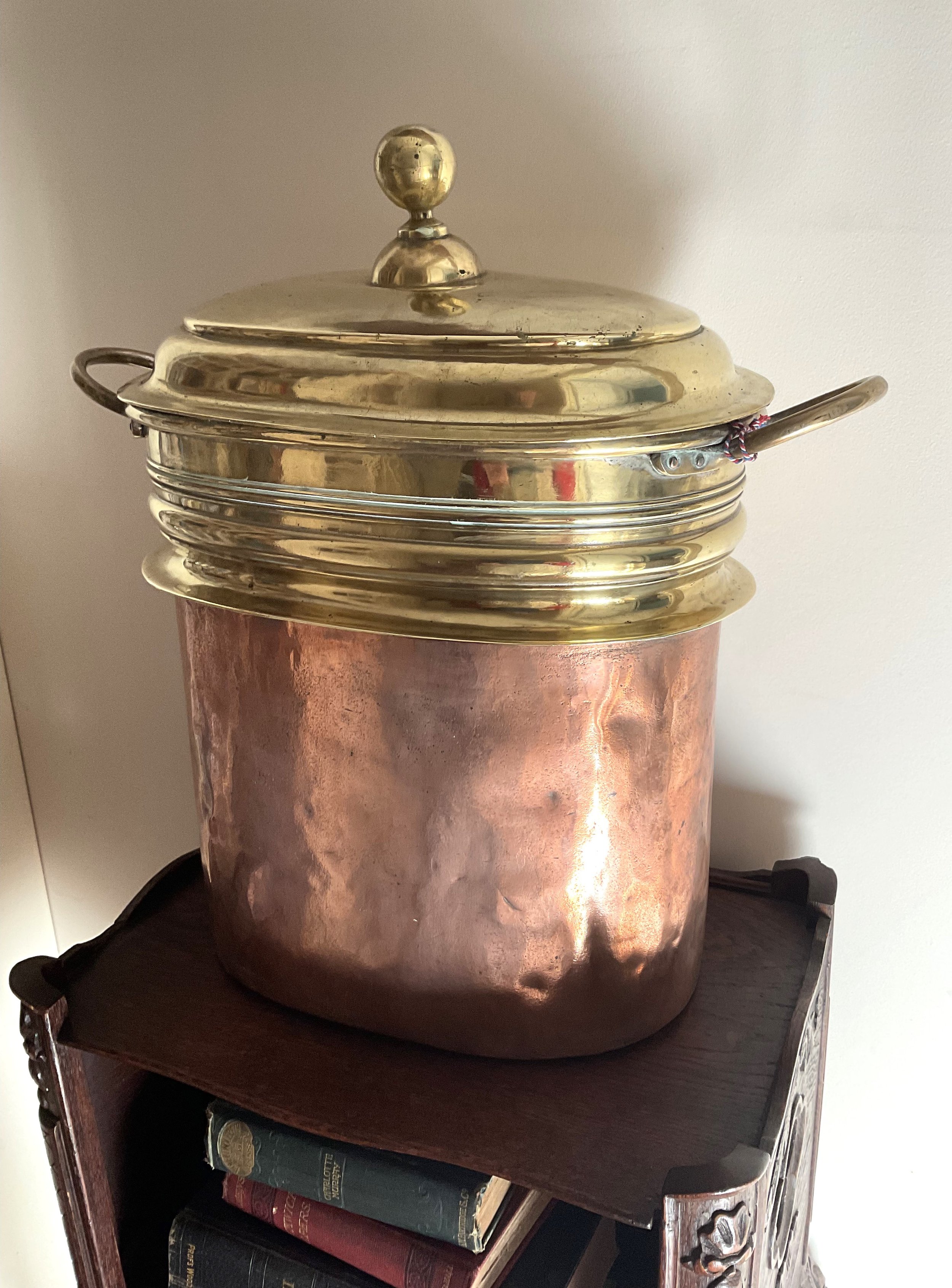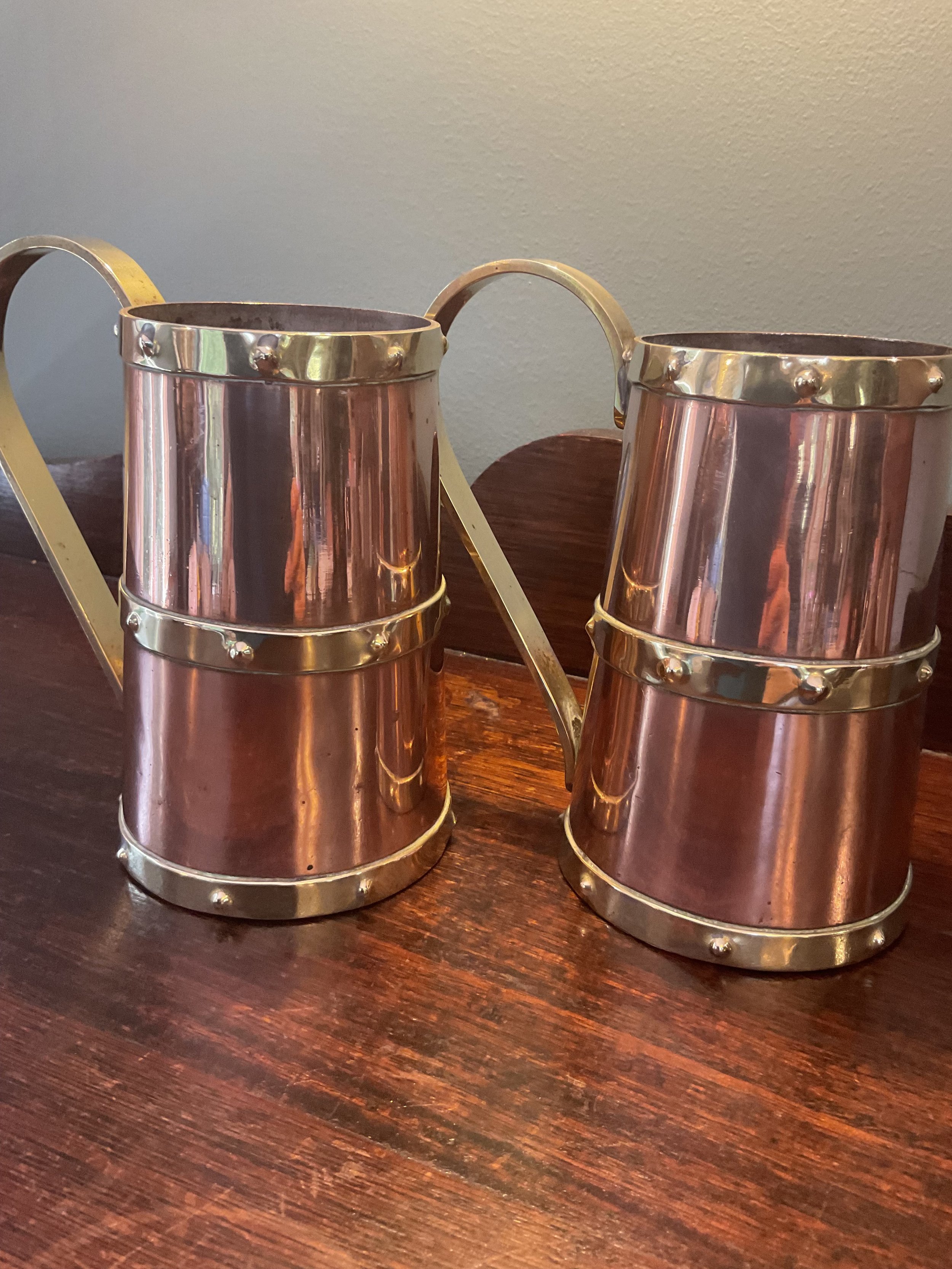 Image 1 of 7
Image 1 of 7

 Image 2 of 7
Image 2 of 7

 Image 3 of 7
Image 3 of 7

 Image 4 of 7
Image 4 of 7

 Image 5 of 7
Image 5 of 7

 Image 6 of 7
Image 6 of 7

 Image 7 of 7
Image 7 of 7








French Antique Poissoniere
This gorgeous French antique fish poacher has a lustrous patina. Circa 1900, it has a thickly rolled rim., with a heavy guage wrought iron swing handle, rivet joined to the short ends. The interior has been tin lined.
It is hard to discern the exact date of when copper cookware was first introduced. Pieces have been discovered in regions of the middle east that date back to 9000BC. Beginning in the 1700s, French cuisine became an acknowledged element of French culture. Skilled French craftsmen began to create and perfect high quality cookware. Many pans from the early 1800s and into the 1930s (until WW11) were made of extra thick copper, featuring ornate brass or cast-iron handles. Prior to the 1850s, copper pans were completely hand made. By the early 1900s, they were made with the assistance of powered machinery. Stamps were often pressed into the copper with words, logos and symbols. This can be very useful when attempting to identify information, such as the time the pan was made or who made it. French kitchens were filled with the warmth of copper cookware, creating a vision of copper pans organised on racks or hanging above cookers. Old copper cookware that has intact lining is still magnificent to cook with. Villediei-les-Poeles in Normandy is known as the ‘copper city’ of France because of its talented copper artisans. It is a beautifully preserved medieval town. Then, why use copper pans? The heat in a copper pan is distributed evenly and food is less likely to become burnt or stuck to the pan. Copper is an excellent conductor of heat so pans also heat up quickly. Copper can be put into the oven and it makes an excellent choice for presentation at the table due to its stunning appearance. Copper pans have been lined with tin for centuries. During the 18th and 19th centuries it became common for French people to send away the copper pans to be re-tinned. Copper on its own, can be highly reactive with acidic foods. To prevent copper from leaching into food, the copper pan’s inner surface is lined with a tin coating. Tin is an inert material that is highly non-reactive and tin sticks readily to copper. Re-tinning usually takes place every 10 to 20 years, depending on how often it is used. A standard rule of thumb – when you see and area of copper the size of a dollar coin, the pan needs to be re-tinned. Whether damaged or aged, copper cookware can be relined with tin, making for a pot that will literally last for centuries.
This poissoniere could be easily repurposed and would look completely at home in a French style kitchen. Imagine it filled with little pots of fresh herbs, or bunches of dried lavender! This fish poacher is 12 cms in height, 53 cms in length and 15.5 cms in width.
This gorgeous French antique fish poacher has a lustrous patina. Circa 1900, it has a thickly rolled rim., with a heavy guage wrought iron swing handle, rivet joined to the short ends. The interior has been tin lined.
It is hard to discern the exact date of when copper cookware was first introduced. Pieces have been discovered in regions of the middle east that date back to 9000BC. Beginning in the 1700s, French cuisine became an acknowledged element of French culture. Skilled French craftsmen began to create and perfect high quality cookware. Many pans from the early 1800s and into the 1930s (until WW11) were made of extra thick copper, featuring ornate brass or cast-iron handles. Prior to the 1850s, copper pans were completely hand made. By the early 1900s, they were made with the assistance of powered machinery. Stamps were often pressed into the copper with words, logos and symbols. This can be very useful when attempting to identify information, such as the time the pan was made or who made it. French kitchens were filled with the warmth of copper cookware, creating a vision of copper pans organised on racks or hanging above cookers. Old copper cookware that has intact lining is still magnificent to cook with. Villediei-les-Poeles in Normandy is known as the ‘copper city’ of France because of its talented copper artisans. It is a beautifully preserved medieval town. Then, why use copper pans? The heat in a copper pan is distributed evenly and food is less likely to become burnt or stuck to the pan. Copper is an excellent conductor of heat so pans also heat up quickly. Copper can be put into the oven and it makes an excellent choice for presentation at the table due to its stunning appearance. Copper pans have been lined with tin for centuries. During the 18th and 19th centuries it became common for French people to send away the copper pans to be re-tinned. Copper on its own, can be highly reactive with acidic foods. To prevent copper from leaching into food, the copper pan’s inner surface is lined with a tin coating. Tin is an inert material that is highly non-reactive and tin sticks readily to copper. Re-tinning usually takes place every 10 to 20 years, depending on how often it is used. A standard rule of thumb – when you see and area of copper the size of a dollar coin, the pan needs to be re-tinned. Whether damaged or aged, copper cookware can be relined with tin, making for a pot that will literally last for centuries.
This poissoniere could be easily repurposed and would look completely at home in a French style kitchen. Imagine it filled with little pots of fresh herbs, or bunches of dried lavender! This fish poacher is 12 cms in height, 53 cms in length and 15.5 cms in width.
Not suitable for delivery via Australia Post. Collection by appointment. Please make contact if you would like to arrange another type of delivery. Free delivery to some Melbourne metropolitan areas can be arranged.




































